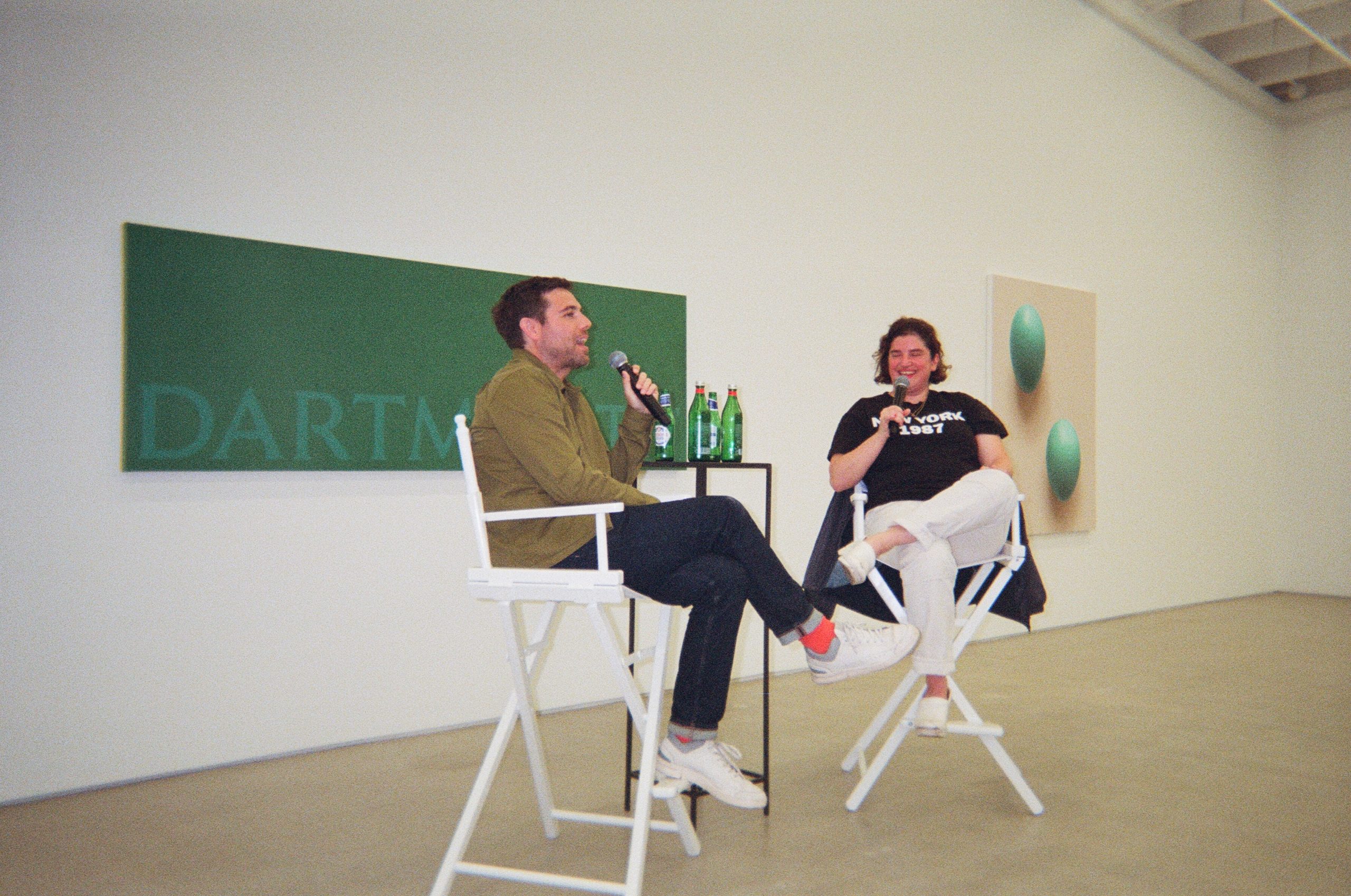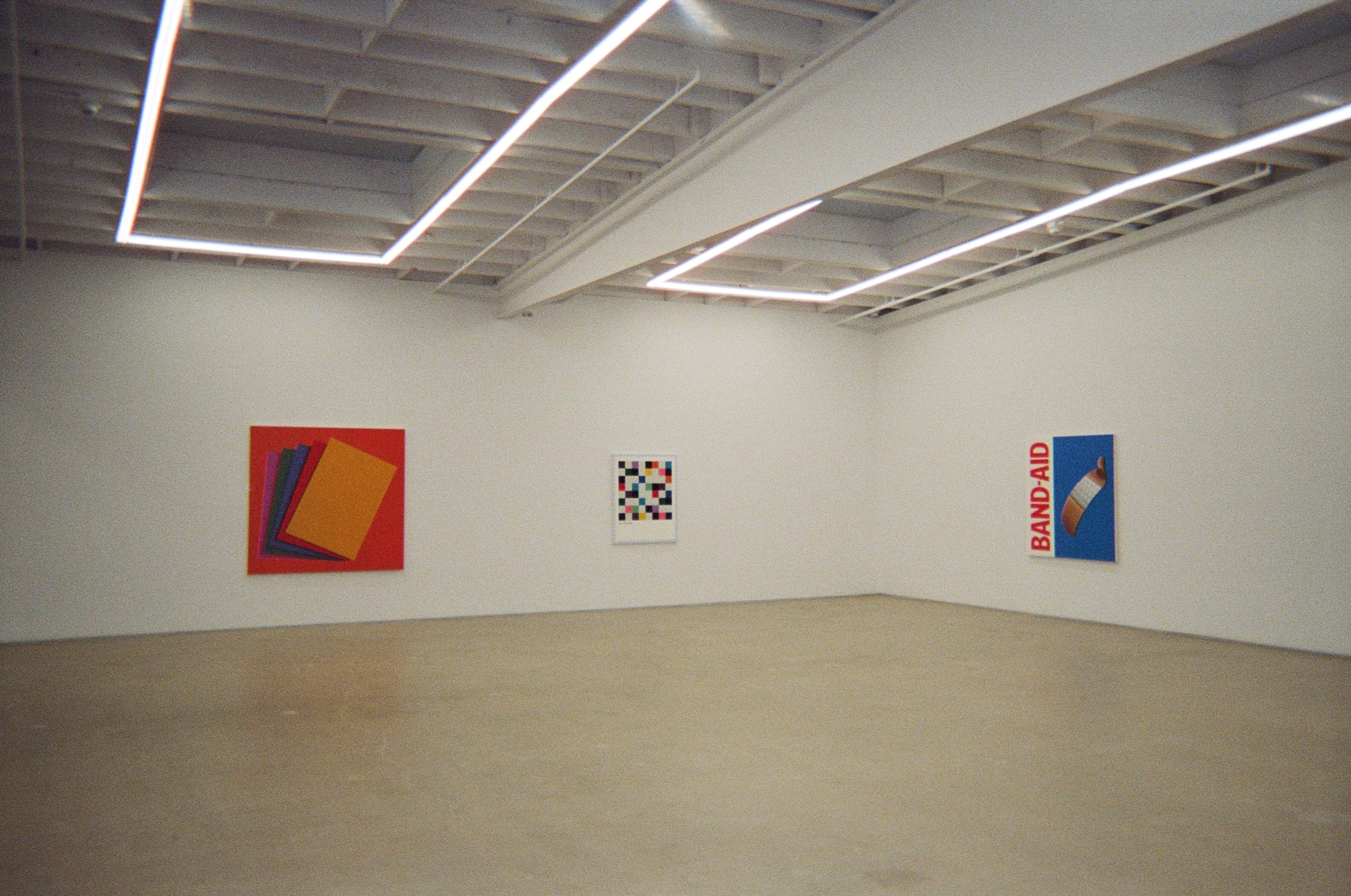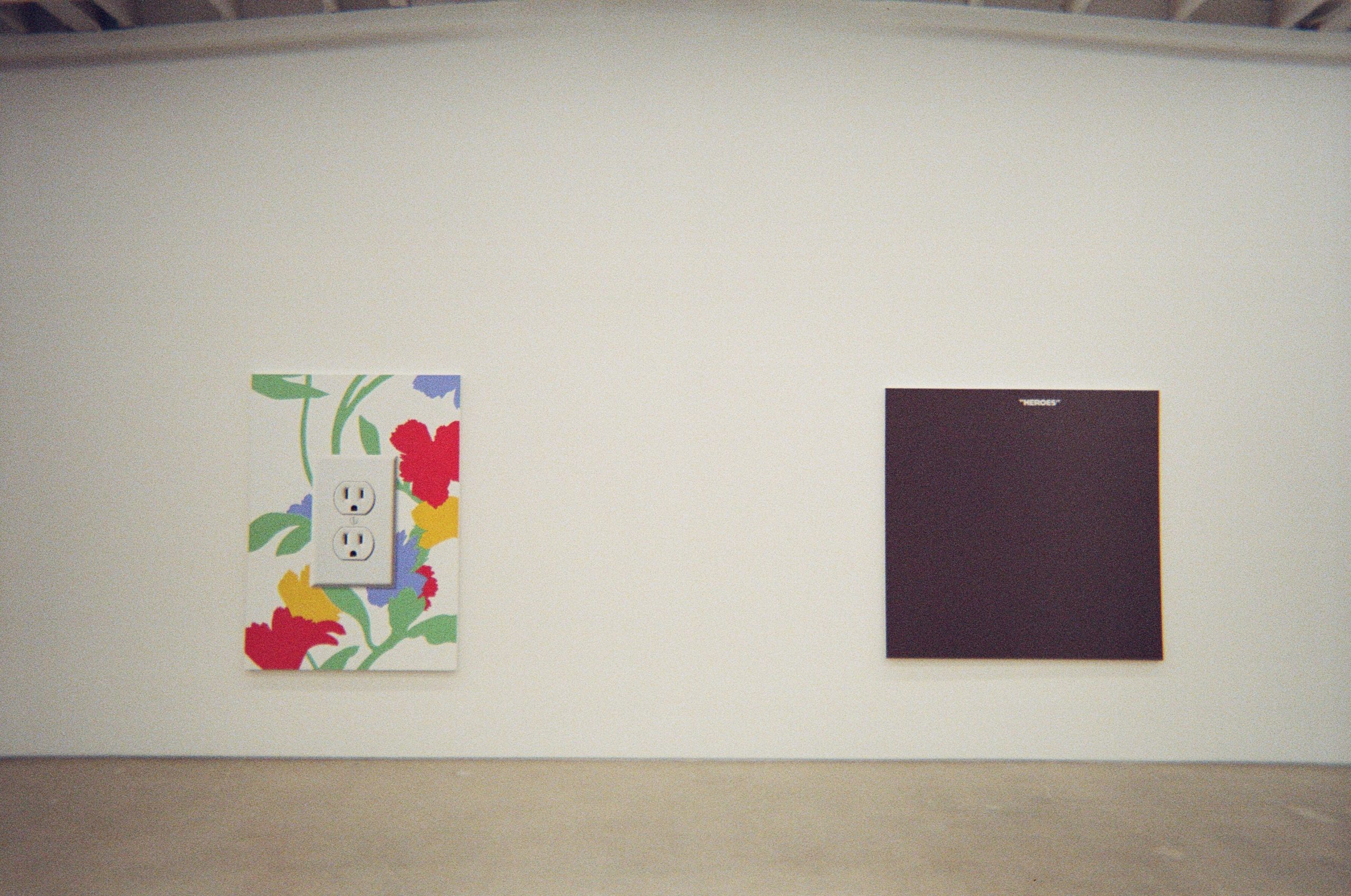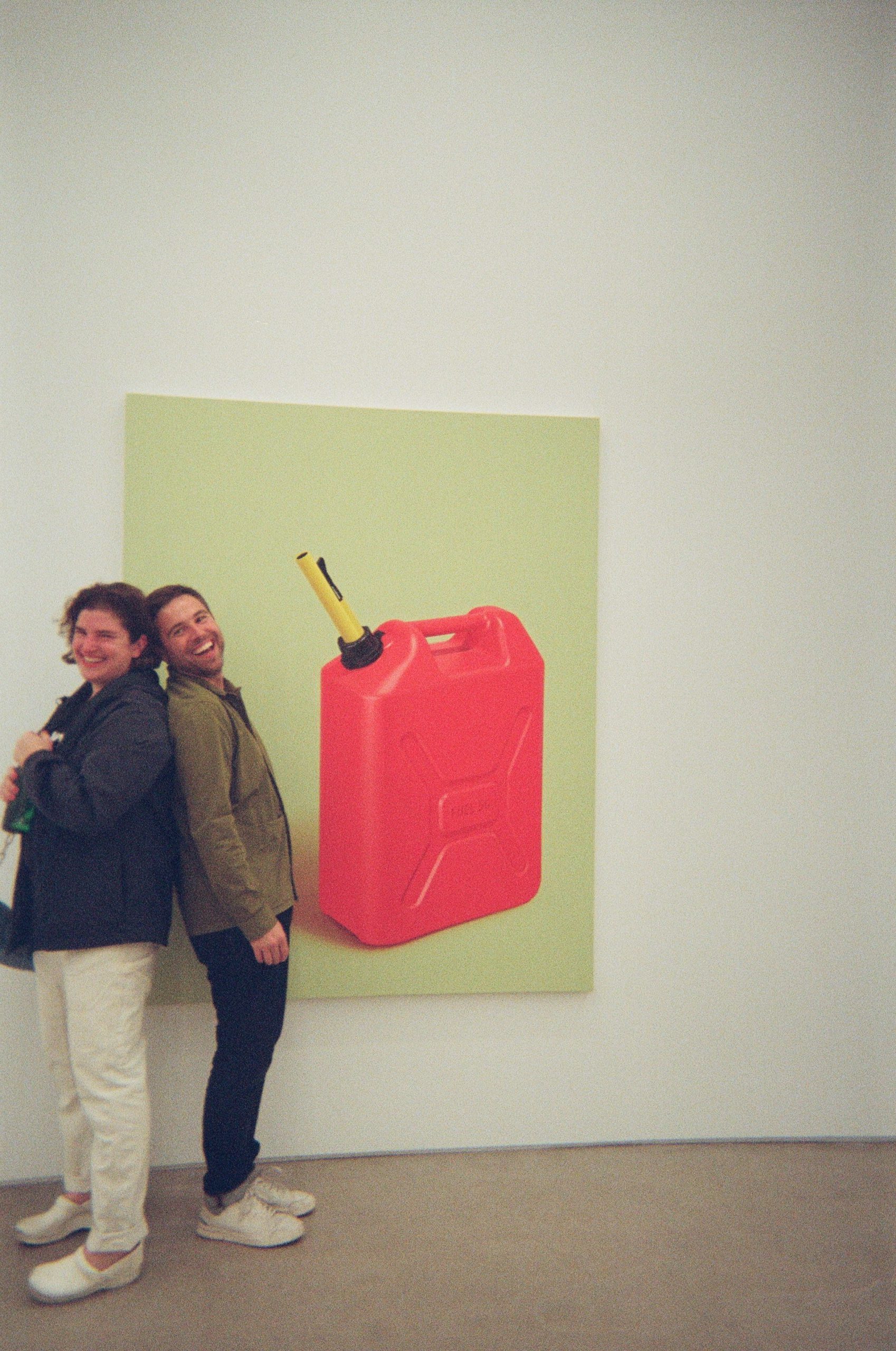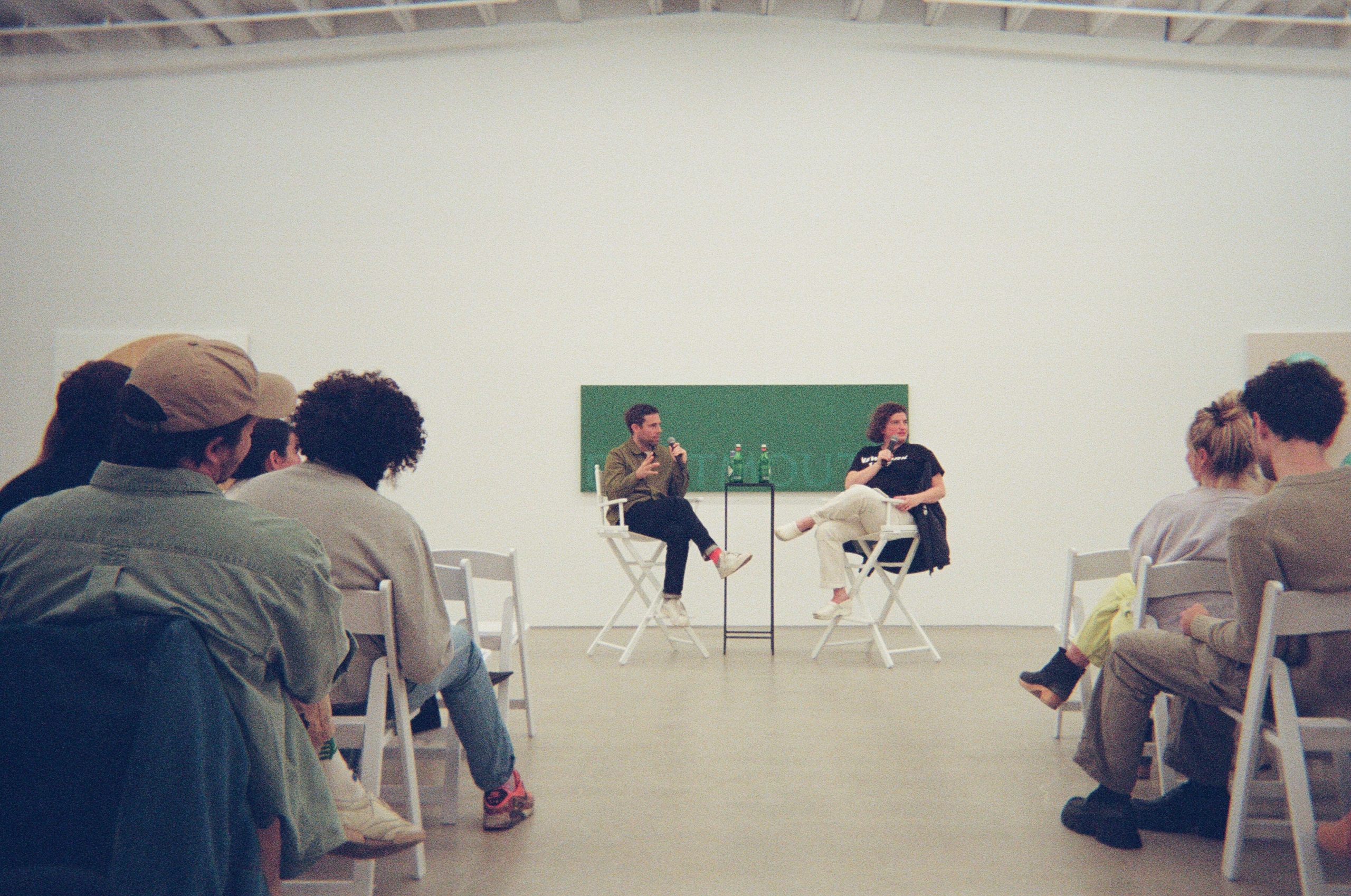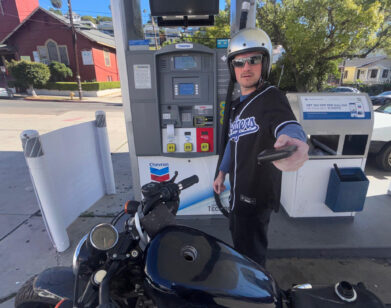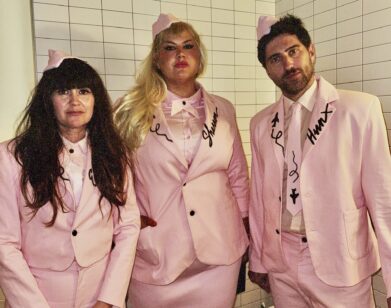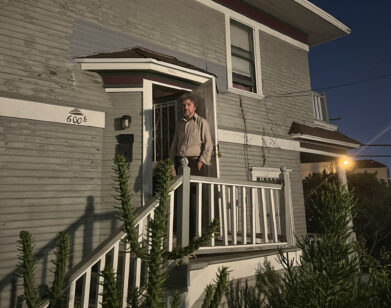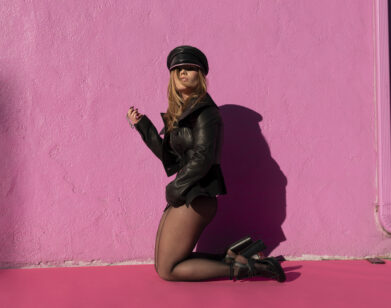IN CONVERSATION
Mathew Cerletty and Naomi Fry on Sconces and “Suburban Dread”
Mathew Cerletty burst on the art scene in the early 2000s (at Rivington Arms) with his eerie, astute, pastel-hued paintings of youth in various states of desire or distress. He could have ridden that wave of figuration for the rest of his career. But Cerletty has always been a journeyman painter, seemingly unsatisfied with one genre or subject, trying out different lenses, going abstract, bringing the subject down to simple lines, and then making a hard turn back to realism with quotidian objects that range from a simple gas can to a box of Band-Aids. The gas can is reminiscent of Elizabeth Bishop’s poem “The Filling Station” with her ode to the beauty of the most mundane items in its last lines: “Somebody/arranges the rows of cans/so that they softly say:/esso—so—so—so/to high-strung automobiles./Somebody loves us all.” There is a hint of love and Bishop-like consideration in Cerletty’s totems of the ordinary, imbued partly with nostalgia, partly with the appreciation of the overlooked, creating a mental puzzle for the viewer to solve. This winter, Cerletty showed his latest, and largest, suite of paintings at Karma in Los Angeles, a portrait gallery of American artifacts—including an elegant nod to Pretty Woman and Triscuits. The writer Naomi Fry spoke with Cerletty about his curious devotions.—CHRISTOPHER BOLLEN
———
NAOMI FRY: We can start with the title of the show, True Believer, which seems to me kind of loaded in a way. I would love to hear you talk about it a little bit and say how you came to choose this particular title.
MATHEW CERLETTY: It’s a term that I’ve used for years to refer to artists that seem like they have some kind of supernatural self-confidence, like everything they touch is art.
FRY: Can you think of examples of artists like that?
CERLETTY: I used it about Brice Marden.
FRY: Okay.
CERLETTY: But I don’t want that to sound like an insult.
FRY: Of course.
CERLETTY: It’s just not how I see myself, so I admire people that have that attitude.
FRY: And so, naming the show that, is it kind of like an auto-suggestion or some sort of like, imbuing the works in the show with that sensation or vibe that you associate with this? Or, is it kind of, you know, a bit of a wink, like, “I’m not a true believer”?
CERLETTY: It’s a little of both. I guess it’s an aspiration of mine. And I feel like this show is a step in that direction for me. I think I wouldn’t have been able to say that that was a goal in my head a few years ago. And I would build more ways of undercutting the work itself into the work. But yeah, It’s not just a term for artists, obviously. You know, the climate that we’re living in, people are believing in all kinds of things that don’t connect to the way I see reality. It just kind of spoke to that. So it just got the ball rolling on what it might be like to look at these works and, on the one hand, see something very sincere, and on the other hand, see something that feels like a joke.
FRY: And you just said that you feel like this is the kind of thing that you wouldn’t have even tried to associate with your work a few years ago. But now it seems like you’re moving a little bit more in that direction.
CERLETTY: Basically, I feel like I can build the contradiction into the work.
FRY: Can you think of something, a work you’ve done before or a group of works, where you feel like it was itemized, or sort of divided?
CERLETTY: When I was doing figurative work, I would glue prosthetic teeth onto, like, the smile of a painting. I did another portrait where there was a strip of wood that just obliterated a painted face. I also just feel more connected to painting, working for 20 years now. More and more I’ve built the formal skills that it takes to make a successful painting. So I can take more complicated ideas and merge them with some of those techniques.
FRY: Let’s talk about your process a bit. Why and how do you choose the things that you choose to paint? Because as Sabrina said when she introduced the work, she said”Mat paints these things that might be otherwise overlooked or just part of the noise that we encounter visually in our everyday life, and then he makes it grand.” So how do you decide—
CERLETTY: Why do that?
FRY: Why Dartmouth? Why Dartmouth?
CERLETTY: [Laughs] Come on.
FRY: [Laughs]
CERLETTY: I think of painting basically as a kind of high-level fancy thing—
FRY: Mm-hmm.
CERLETTY: And paintings are meaningful. Somebody’s going to make them by hand, and I know a lot of traditional techniques. What I want to find to plug into that is something typically undeserving or surprising as a painting subject. I want you to wonder.
FRY: Mm-hmm. Mm-hmm.
CERLETTY: Like the sconces over there.
FRY: You’re good at sconces?
CERLETTY: I’m one of the best sconce painters, yeah.
FRY: [Laughs]
CERLETTY: [Laughs] That’s just a Home Depot.
FRY: Is it from a catalog?
CERLETTY: I Googled sconce. Some of them I did from scratch. I worked with a photographer. I’ve done that on a few of these, but when I just can’t find the right sconce I have to do it myself.
FRY: What is the right sconce?
CERLETTY: It already looks like a painting and it already feels—
FRY: It’s a feeling.
CERLETTY: Yeah. It’s like no one’s gonna paint this sconce. I’ve got the sconce market cornered.
FRY: That’s so interesting. Is there a kind of swagger involved in a way?
CERLETTY: [Laughs]. There’s a little swagger to that part of it.
FRY: Do you go for stuff that you know you’re gonna do well, or is there a level of experimentation where you’re like, “Okay, I’m gonna choose something that I’m not sure I can do”?
CERLETTY: It’s incremental. I’m pretty careful. There’s such a long process of testing it out. These images are all built on the computer way before I have any paint out. I’ll print it and pin it to my wall and it might sit there for a year or something and not happen. Like for the [Dartmouth painting], I thought “Okay, that could be sort of interesting and slightly provocative.” I think I tried Stanford and Harvard and a bunch of schools and it just didn’t work and I put it away. And I was like, “I think maybe it can’t be the first top college that you think of.”
FRY: Yeah.
CERLETTY: It’s gotta be a little weird. And so I was like, “Okay, Dartmouth, that’s interesting.” So it just slows down the process of you saying, “Oh, I get it. You’re doing like, a bumper sticker that someone would be proud of their child or whatever on the back of your car.” And you’re making it into a monochrome fancy painting.
FRY: Yeah.
CERLETTY: It needed a bunch of little qualities to kind of make it be more than that one liner.
FRY: It’s interesting because it is a feeling. Like when you say, “Oh, it can’t be Harvard or Yale, it has to be Dartmouth,” or it could be Williams or something?
CERLETTY: [Laughs] It could work.
FRY: There’s a specificity there. Obviously your choices are very careful and require a lot of work to bring them into fruition. But just hearing you talk about it, it seems that a lot of it is based on a feeling that has to do with color and texture.
CERLETTY: Mm-hmm.
FRY: I don’t know if other people have this, but when I think about years, they have feelings to them. Like 1968 evokes a very different feeling from 1967 for me. Like, all of my ideas about hippie beats are from 1967. For 1968, black leather might start to come in. Or maybe heroin. It imbues it with a color, a sensation. And I almost feel that when I hear you talk about your choices. It’s not totally rational. Does that ring a bell?
CERLETTY: I’m really not very strategic. Like, Triscuit for example. My dad ate Triscuits every night after dinner with wine.
FRY: With wine?
CERLETTY: He would sit and read a book—
FRY: That’s so interesting.
CERLETTY: I would go into this room and he would listen to classical music, and I would go and, like, grab a Triscuit, and take a little sip of wine, and a piece of cheese.
FRY: That’s so pleasurable. How old were you?
CERLETTY: My entire childhood, it was always like this.
FRY: I love Triscuits.
CERLETTY: My cat’s name is Triscuit.
FRY: Oh, wow. That’s a big reveal.
CERLETTY: At some point, it was just kind of like, why have I not painted Triscuit? This is obvious. I have to. I’m a huge commenter on their Instagram.
FRY: [Laughs]
CERLETTY: And I’m really, really critical of the designs. They respond and we go back and forth.
FRY: What do you say?
CERLETTY: I just feel like they don’t know what they’re doing. They don’t know what they have.
FRY: Maybe you need to step in.
CERLETTY: I would love to [laughs].
FRY: Now they do that crazy thing where there’s a trillion flavor profiles.
CERLETTY: I don’t like all that dust. No rosemary dust, no.
FRY: There’s a cracked pepper and olive oil one that my daughter is a very big fan of.
CERLETTY: They make pico de gallo now. They’ve lost it.
FRY: Crazy stuff. It’s like you’re holding on to something in this work. Would you call it nostalgic?
CERLETTY: I think it is. I don’t love that about it.
FRY: Right.
CERLETTY: Those are words I’m supposed to avoid as a cool, deadpan artist. But I think that aspect of it is actually a way to kind of create a relationship with something unexpected. But I hope that painting doesn’t feel nostalgic. At least not right now. But hearing you talk about it, it does look different now. That particular logo profile used to be primary colors.
FRY: Yeah.
CERLETTY: At first, I was thinking like, “Oh, should it be kind of a wheat color?” Which is what they’re doing now. But it’s too busy.
FRY: Maybe I should start commenting on their Instagram. [Laughs]
CERLETTY: We’ve got to take over. We should do a Triscuit takeover. [Laughs].
FRY: Enough writing, enough art. Speaking of logos, the Pretty Woman piece that’s around the corner—
CERLETTY: Mm-hmm. Yeah.
FRY: It’s just so iconic, and it’s so recognizable. At least to people from our generation. I don’t know if younger people would have that same visceral reaction to it. How’d that come about?
CERLETTY: My mom had the tape, and I would come home from school and take it off her shelf and watch it. And I felt like I was doing something wrong. It was, like, Flashdance and Pretty Woman and The Big Chill were all on this shelf.
FRY: Right. High concept 80s movies. Or, I guess, Pretty Woman is 1990.
CERLETTY: [Laughs] Yeah. I just loved it and watched it a million times, and I think I watched it over the pandemic at one point. And this thing holds up. I didn’t expect it to.
FRY: I haven’t watched it in so long. Maybe I should watch it. It’s interesting because, of course, like, the actual poster, at least as I recall it, had Richard Gere and Julia Roberts. Maybe he has suspenders, and she’s wearing her hooker boots and thigh-highs. I think people were complaining that in the poster his hair was black. And as we remember, he was a silver fox in the movie.
CERLETTY: Totally.
FRY: But you just did the lettering.
CERLETTY: Yeah.
FRY: You used to do figuration in your work. Are you now done with people?
CERLETTY: Never say never.
FRY: Mm-hmm.
CERLETTY: I feel like at some point along the way the figure in the work started to feel like a third wheel in the relationship I was trying to have with the viewer. I could narrow the focus of somebody else that’s looking at the work if there isn’t another person. Inevitably, you’re going to bring a million interpretations to and a ton of baggage.
FRY: Yeah.
CERLETTY: I want to talk to whoever the person is that’s looking at the painting.
FRY: Do you think it has to do with, like, an aspiration to a kind of seamlessness or perfection in your work? Not that you can’t draw figures perfectly well, but is there something more messy about the human form? Superfluous, almost? Or it doesn’t lend itself as much to the kind of seamless formality—
CERLETTY: Well, I want these to feel like the epitome of a gas can.
FRY: Yeah.
CERLETTY: But you can’t have the epitome of a person. It doesn’t make any sense. A perfectly generic person doesn’t exist.
FRY: Yes. Right. Maybe in the metaverse [Laughs].
CERLETTY: Yeah. [Laughs]. But I feel like that’s not a person, right?
FRY: I could see you doing a metaverse character maybe. As a certain generic, scary—
CERLETTY: I was trying to do a silhouette of a figure for this show and I couldn’t figure it out. I’m rooting for this to come back, but it has to somehow be disguised or just generic enough that everybody could kind of see it and be like, “Okay, that’s just a stand-in for me.”
FRY: Right. Yeah.
CERLETTY: But I think of all of these as kind of stand-ins for whoever’s looking at them.
FRY: What is the feeling that you would ideally want the work to evoke in people? Not scary in any conventional sense, right? But eerie, maybe?
CERLETTY: Yeah.
FRY: There’s something a little bit menacing about them. For me at least, maybe I’m just bringing my own associations and history into this. Like, the menace has to do with America [laughs]. It evokes a kind of suburban dread. Class aspiration, maybe. Or a desire for predictable comfort.
CERLETTY: I want them to feel charged. Whatever the highest level I can get them without you going, like, “Oh, I see what you’re doing.” I want the colors to be as saturated as they can be without stepping over this certain line. I’m trying to make images that are just as emphatic as they can possibly be. I’m using a lot of advertising language, stock photo stuff.
FRY: Is pop important to you? Because pop was also about the seduction of the material world. But often your things are almost a shade down from pop. They’re a little bit more willfully boring.
CERLETTY: Yeah.
FRY: What’s the process like when you work on a painting of this size? Do you do a lot sketches before? Or do it with colored pencil? Or just go right in on the canvas?
CERLETTY: I’ll mock it up on the computer, and that’s usually photographs kind of stitched together or something. If it seems like it has potential, I’ll email it to Erin, my partner.
FRY: So there’s a back and forth?
CERLETTY: I like getting feedback, yeah. After that, there’ll be some more refining. Then I’ll take a projector and put it on the wall. When you look at it at different scales, oftentimes that’ll show me something that’s not working, that I can’t see when it’s smaller. I was pretty nervous about filling this place. This is the biggest show I’ve ever done.
FRY: How long have you been working on this body?
CERLETTY: A year-and-a-half. Something like that.
FRY: You knew from the start—
CERLETTY: They showed me the floor plan and they were like, “You’re gonna need to go big here.” And I’ve never done a show with this many works in it. I hoped they could kind of play off of each other in different ways. Because in something like this one, or Triscuit or, um, Pretty Woman, you don’t feel long hours of me in my studio working on the thing, they’re sort of light on their feet and they’re clearly idea-driven.
FRY: Did you think at all about where the show will be, not just specifically this space, but that this is an LA show?
CERLETTY: I always think about that a lot. It just made Pretty Woman seem like that much better of an idea.
FRY: Right.
CERLETTY: At a certain point, I was thinking of titling the show Plain Dealer, like the Cleveland newspaper.
FRY: Interesting.
CERLETTY: It’s interesting to go to California and bring some of my Midwestern references. Though it’s a pretty normal story to come out to the coast from one of those spots.
FRY: From the middle to the edges. That’s something that has to do with what I was saying about pop before, because pop is the coast. In some ways, these works are an enormous flex. They’re really big, you’re showing what you can do. You’re taking up space.
CERLETTY: It’s my Milwaukee flex.
FRY: It’s as much as a Milwaukee guy can flex. Thank you, Mat.
CERLETTY: Thank you.

